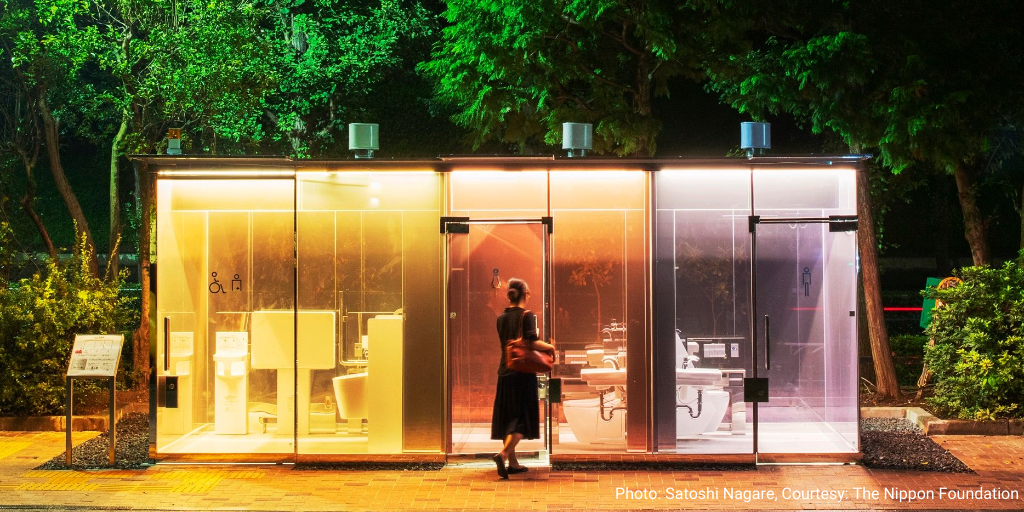Public restrooms with see-through walls: I’ll explain
Lesson summary
Hi there, thanks for joining us for Plain English, your favorite way to practice English with current events. Today it’s another article about Japan—you know I love these—and the [unique toilets] in Tokyo. I’m Jeff, by the way, and JR is the producer. JR has posted the full lesson online at PlainEnglish.com/290 because, well, this is Plain English lesson number 290.
This lesson also has a phrasal verb. That is “make out,” the G-rated definition. And we have a quote of the week as well.
Transparent restrooms in Tokyo parks
What are the two primary concerns about using a public restroom in a park? For many people, they are cleanliness and safety. Before entering a single-person restroom, you want to make sure nobody is inside waiting for you and that it is at least relatively clean. This can be a problem when the doors are closed and you can’t see inside.
Introducing the newest invention in public sanitation: the public restroom with see-through walls. It is the invention of Shigeru Ban, an architect in Tokyo, and it is part of THE TOKYO TOILET Project, a public-private initiative that aims to redesign public restrooms in 17 locations throughout Shibuya, a district in Tokyo. The project will invite 16 different architects and designers to submit their own unique designs.
According to THE TOKYO TOILET Project web site, “toilets are a symbol of Japan’s world-renowned hospitality culture”—that is true. Japan is famous for its high-tech and luxurious toilets; Tokyo is home to the world’s biggest high-tech toilet museum.
The purpose of [this toilet renovation project] is to break the stereotype that says public restrooms are dirty, smelly, [dark and scary]. The site also explains that “public toilets must stand the test of time” and that maintenance and cleaning are critical. The Nippon Foundation, which is [implementing] the initiative, says that its goal is to make people feel comfortable using the toilets and to “foster a spirit of hospitality for the next person.”
The project was meant to coincide with the Tokyo Olympics this summer. Japanese hospitality follows a principle called omotenashi, according to the Nippon Foundation. Omotenashi means “to wholeheartedly look after guests.” THE TOKYO TOILET Project was intended to bring that principle to the public spaces in one of Japan’s busiest commercial areas.
Mr. Ban’s see-through public toilets have already been installed in Yoyogi Fukamachi Mini Park and Haru-no-Ogawa Community Park. I should clarify that they are transparent only when empty. After a person enters and engages the lock, the walls turn opaque—meaning that you cannot see inside [from the outside, and you cannot see out from the inside.]
The design aims to make public toilets more inviting and visually pleasing for park visitors; indeed they do look welcoming. Here’s what they look like. They are small; don’t picture a large building with two big entrances. Instead, picture a bank of three individual spaces, each a bit larger than a portable toilet, but smaller than a normal-sized restroom. One space is for handicapped users; one is for men; and one is for women. Put together, the three cubicles are about the size of a large newsstand or a small café that you might find in a park. The exterior walls and doors are all made of glass. The glass for each cubicle is a different color. In the image I saw, one is yellow; one is purple; and one is orange.
When the cubicles are unoccupied, you can see through the colored glass. You can clearly see a toilet, a sink, and, in the case of the handicapped restroom, a baby changing table. They are well-lit from the inside, so you can see if there is any trash around or if the surfaces are clean.
After a person enters and [locks] the door, the glass becomes frosted, meaning that you can no longer see through it. The colors are the same, but you can no longer see through. It just looks like a well-lit orange, yellow, or purple door. The architect’s web site says that—whether occupied or not—the facility “lights up the park like a beautiful lantern.”
The rest of the installations from the other architects will be complete by August 2021.
Join our free Facebook group
By the time you hear this, I will already be on vacation. I’ve decided to do a long road trip out west and I’ll be spending a fair amount of time in parks, big and small, and I’ll be on the lookout for any park restrooms that are even more fun than the Tokyo Toilet Project restrooms.
If you’re curious about what these look like, I’ll post a link to some photos in our free Facebook group. If you’re not yet in the Plain English Facebook group, you can join very easily. See if you remember the URL. Here we go: PlainEnglish.com/Facebook I made it easy on you. Just enter that into your phone or browser and it will automatically open our Facebook group for you. PlainEnglish.com/Facebook and I’ll post a picture of the fancy Tokyo toilets. You can tell me what you think, and tell me how these compare to the best public restrooms where you live. PlainEnglish.com/Facebook.
Great stories make learning English fun

